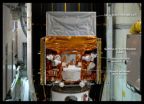(Press-News.org) Thanks to improved data analysis techniques and a new operating mode, the Gamma-ray Burst Monitor (GBM) aboard NASA's Fermi Gamma-ray Space Telescope is now 10 times better at catching the brief outbursts of high-energy light mysteriously produced above thunderstorms.
The outbursts, known as terrestrial gamma-ray flashes (TGFs), last only a few thousandths of a second, but their gamma rays rank among the highest-energy light that naturally occurs on Earth. The enhanced GBM discovery rate helped scientists show most TGFs also generate a strong burst of radio waves, a finding that will change how scientists study this poorly understood phenomenon.
Before being upgraded, the GBM could capture only TGFs that were bright enough to trigger the instrument's on-board system, which meant many weaker events were missed.
"In mid-2010, we began testing a mode where the GBM directly downloads full-resolution gamma-ray data even when there is no on-board trigger, and this allowed us to locate many faint TGFs we had been missing," said lead researcher Valerie Connaughton, a member of the GBM team at the University of Alabama in Huntsville (UAH). She presented the findings Wednesday in an invited talk at the American Geophysical Union meeting in San Francisco. A paper detailing the results is accepted for publication in the Journal of Geophysical Research: Space Physics.
The results were so spectacular that on Nov. 26 the team uploaded new flight software to operate the GBM in this mode continuously, rather than in selected parts of Fermi's orbit.
Connaughton's team gathered GBM data for 601 TGFs from August 2008 to August 2011, with most of the events, 409 in all, discovered through the new techniques. The scientists then compared the gamma-ray data to radio emissions over the same period.
Lightning emits a broad range of very low frequency (VLF) radio waves, often heard as pop-and-crackle static when listening to AM radio. The World Wide Lightning Location Network (WWLLN), a research collaboration operated by the University of Washington in Seattle, routinely detects these radio signals and uses them to pinpoint the location of lightning discharges anywhere on the globe to within about 12 miles (20 km).
Scientists have known for a long time TGFs were linked to strong VLF bursts, but they interpreted these signals as originating from lightning strokes somehow associated with the gamma-ray emission.
"Instead, we've found when a strong radio burst occurs almost simultaneously with a TGF, the radio emission is coming from the TGF itself," said co-author Michael Briggs, a member of the GBM team.
The researchers identified much weaker radio bursts that occur up to several thousandths of a second before or after a TGF. They interpret these signals as intracloud lightning strokes related to, but not created by, the gamma-ray flash.
Scientists suspect TGFs arise from the strong electric fields near the tops of thunderstorms. Under certain conditions, the field becomes strong enough that it drives a high-speed upward avalanche of electrons, which give off gamma rays when they are deflected by air molecules.
"What's new here is that the same electron avalanche likely responsible for the gamma-ray emission also produces the VLF radio bursts, and this gives us a new window into understanding this phenomenon," said Joseph Dwyer, a physics professor at the Florida Institute of Technology in Melbourne, Fla., and a member of the study team.
Because the WWLLN radio positions are far more precise than those based on Fermi's orbit, scientists will develop a much clearer picture of where TGFs occur and perhaps which types of thunderstorms tend to produce them.
The GBM scientists predict the new operating mode and analysis techniques will allow them to catch about 850 TGFs each year. While this is a great improvement, it remains a small fraction of the roughly 1,100 TGFs that fire up each day somewhere on Earth, according to the team's latest estimates.
Likewise, TGFs detectable by the GBM represent just a small fraction of intracloud lightning, with about 2,000 cloud-to-cloud lightning strokes for every TGF.
INFORMATION:
The Fermi Gamma-ray Space Telescope is an astrophysics and particle physics partnership and is managed by NASA's Goddard Space Flight Center in Greenbelt, Md. Fermi was developed in collaboration with the U.S. Department of Energy, with important contributions from academic institutions and partners in France, Germany, Italy, Japan, Sweden and the United States.
The GBM Instrument Operations Center is located at the National Space Science Technology Center in Huntsville, Ala. The GBM team includes a collaboration of scientists from UAH, NASA's Marshall Space Flight Center in Huntsville, the Max Planck Institute for Extraterrestrial Physics in Germany and other institutions.
Fermi improves its vision for thunderstorm Gamma-ray flashes
2012-12-06
ELSE PRESS RELEASES FROM THIS DATE:
Researchers find new genetic pathway behind neurodevelopmental disorders
2012-12-06
Researchers at the Douglas Mental Health University Institute, have discovered a new genetic process that could one day provide a novel target for the treatment of neurodevelopmental disorders, such as intellectual disability and autism.
The research study, which appears in the December issue of the American Journal of Human Genetics, was led by Carl Ernst, a Douglas Institute researcher, an assistant professor in McGill's Department of Psychiatry and a Canada Research Chair in Psychiatric Genetics. Ernst and his colleagues found that genetic mutations that negatively ...
Closer look at consumers' gazes
2012-12-06
Montreal, December 6, 2012 – Rows of new toys, endless racks of sweaters on clothing store shelves, long lines of books arranged in the bestsellers section at the bookstore. From mall displays to boutique exhibits, long lines of horizontally arranged products are the norm when it comes to the holiday shopping experience.
But how does a product's placement on the storeroom shelf influence which one a consumer ultimately chooses? It turns out that the shopper's eye has a very central focus.
"Consumers are more likely to purchase products placed in the middle of a display ...
Prenatal tests more informative using microarray technology, find GW researchers
2012-12-06
WASHINGTON – A new method for detecting abnormalities in unborn children is providing physicians with more information to analyze the results than conventional, microscopic testing, according to two George Washington University researchers.
Elizabeth Thom, research professor of epidemiology and biostatistics, and Julia Zachary, senior research scientist, are co-authors of the lead article appearing in the current issue of the New England Journal of Medicine showing that microarray technology provides a more comprehensive result from genetic testing during prenatal care ...
UT MD Anderson study finds link between statins and improved survival in inflammatory breast cancer
2012-12-06
HOUSTON - Researchers from The University of Texas MD Anderson Cancer Center found statins, the commonly used drug to lower cholesterol, improved progression-free survival in patients with inflammatory breast cancer (IBC).
The retrospective study was presented today in a poster discussion at the 2012 CTRC-AACR San Antonio Breast Cancer Symposium and follows a previously reported Danish study indicating there is some evidence to suggest the anti-inflammatory properties of statins could reduce the risk of breast cancer recurrence. Still, the overall effects of statins have ...
Insect-eating bat outperforms nectar specialist as pollinator of cactus flowers
2012-12-06
SANTA CRUZ, CA--Of the two bat species known to visit the flowers of the cardon cactus in Baja California, one depends entirely on nectar and is highly specialized to feed from the flowers, which are adapted for pollination by bats. The other is an insect-eating bat best known for its ability to hear the footsteps of large insects and scorpions and capture them on the ground.
In a surprising result, scientists at the University of California, Santa Cruz, have found that the insect-eating pallid bat is a more effective pollinator of the cactus flowers than the nectar-feeding ...
Tamoxifen trial should prompt breast cancer patients to reconsider treatment options
2012-12-06
MAYWOOD, Il. - A groundbreaking clinical trial involving the breast cancer drug tamoxifen should prompt certain breast cancer patients to reconsider their treatment options, according to Loyola University Medical Center breast cancer specialist Dr. Kathy Albain.
The trial is called ATLAS (Adjuvant Tamoxifen Longer Against Shorter). It included women with estrogen receptor-positive breast cancer that had not spread to distant organs. Women who took tamoxifen for 10 years had a lower risk of recurrence and lower mortality rate than women who took the drug for 5 years, ...
Fit kids finish first in the classroom
2012-12-06
EAST LANSING, Mich. — Fit kids aren't only first picked for kickball. New research from Michigan State University shows middle school students in the best physical shape outscore their classmates on standardized tests and take home better report cards.
Published in the Journal of Sports Medicine and Physical Fitness, it's the first study linking children's fitness to both improved scores on objective tests and better grades, which rely on subjective decisions by teachers.
The study also is among the first to examine how academic performance relates to all aspects of ...
Eating fewer, larger meals may prove healthier for obese women
2012-12-06
COLUMBIA, Mo. – Media articles and nutritionists alike have perpetuated the idea that for healthy metabolisms individuals should consume small meals multiple times a day. However, new research conducted at the University of Missouri suggests all-day snacking might not be as beneficial as previously thought, especially for obese women.
"Our data suggests that, for obese women, eating fewer, bigger meals may be more advantageous metabolically compared to eating smaller, more frequent meals throughout the day," said the study's lead author, Tim Heden, a doctoral student ...
Fire and ice: Wildfires darkening Greenland snowpack, increasing melting
2012-12-06
SAN FRANCISCO—Satellite observations have revealed the first direct evidence of smoke from Arctic wildfires drifting over the Greenland ice sheet, tarnishing the ice with soot and making it more likely to melt under the sun.
At the American Geophysical Union meeting this week, an Ohio State University researcher presented images from NASA's Cloud-Aerosol Lidar and Infrared Pathfinder Satellite Observation (CALIPSO) satellite, which captured smoke from Arctic fires billowing out over Greenland during the summer of 2012.
Jason Box, associate professor of geography at ...
Georgia State physicist, international researchers discover fastest light-driven process
2012-12-06
A discovery that promises transistors – the fundamental part of all modern electronics – controlled by laser pulses that will be 10,000 faster than today's fastest transistors has been made by a Georgia State University professor and international researchers.
Professor of Physics Mark Stockman worked with Professor Vadym Apalkov of Georgia State and a group led by Ferenc Krausz at the prestigious Max Planck Institute for Quantum Optics and other well-known German institutions.
There are three basic types of solids: metals, semiconductors, used in today's transistors, ...


